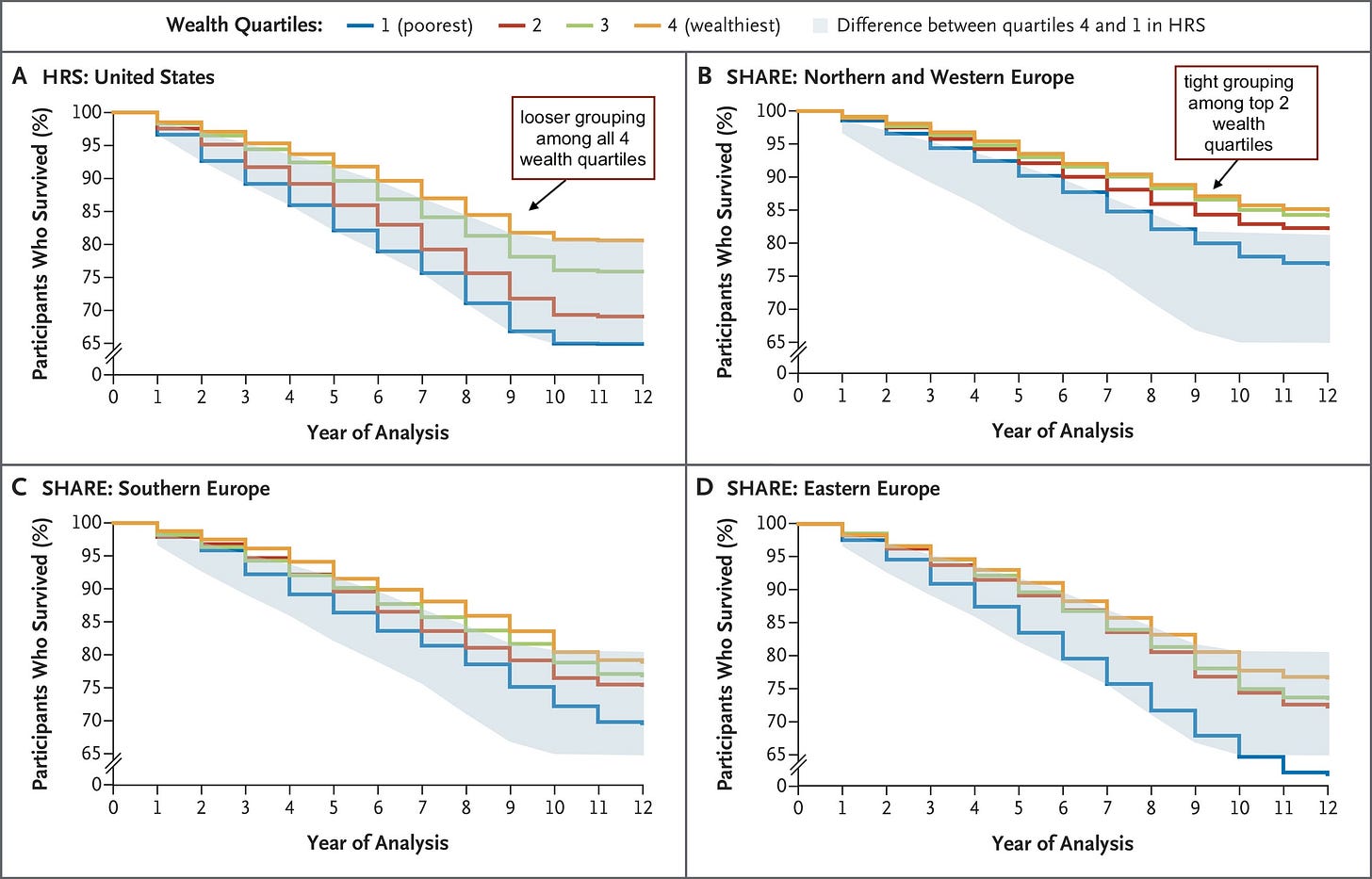Rich Americans die like poor Europeans
Wealth doesn't compensate for crappy diets, a sedentary lifestyle and a stingy healthcare system, new research suggests.
I didn’t intend to write two consecutive AGING with STRENGTH posts about longevity research. But just as I was putting together a post tentatively titled “Aging with sex” — which will publish soon — along comes a new study, out Wednesday, examining how wealth affects mortality in Europe and the United States.
I couldn’t not write about this. Here’s why:
The wealthiest Americans die at roughly the same rates as the poorest northern and western Europeans, the data show. The reasons why aren’t ironclad, but the researchers suspect that increasingly poor dietary habits, sedentary lifestyles and America’s godawful health system are among the primary causes.
What this new wealth/longevity research showed
Researchers at Brown University compared mortality data from 73,838 participants 50 to 85 years old in the United States and Europe between 2010-2022. This group was divided into four quartiles of wealth. Americans were geographically categorized (West, Midwest, South and East). Europeans were divided into three geographic regions: northern and western Europe (Austria, Belgium, Denmark, France, Germany, the Netherlands, Sweden and Switzerland); southern Europe (Italy, Portugal and Spain); and eastern Europe (Czech Republic, Estonia, Hungary, Poland and Slovenia).
The research, published this week in the New England Journal of Medicine, found:
greater wealth was consistently associated with lower mortality across all regions, but….
the gap in survival between the richest and poorest was much wider in the U.S. than in Europe (see chart below)
the wealthiest Americans had lower survival than the wealthiest northern, western or southern Europeans
survival in the wealthiest U.S. quartile appeared similar to that in the poorest quartile in northern and western Europe
the poorest Americans had the worst survival among all groups studied
A screenshot of the findings from the published study:
America: home to “the widest gap” in mortality rates
Look at the four charts (Fig. 1) below. They show survival rates for the four wealth quartiles in the U.S. (upper left chart) and for the three European regions: northern/western, southern and eastern. Notice that:
survival rates for the wealthiest Americans is about the same as those for the poorest western/northern europeans
the northern and western Europeans (chart at top right of Fig. 1) have very tight groupings across income levels; the top 2 wealth tiers are nearly identical for survival rates over 12 years
in the U.S., by contrast, survival rates had much greater variability depending on wealth; look at the space between each color-coded U.S. wealth quartile
“The poorest participants in the United States appeared to have worse survival than all comparator groups,” the study said, “including the poorest quartile in all three European regions.”
What explains high U.S. mortality rates vs. Europeans?
There are many likely reasons beyond the most obvious ones for why Americans, even those with the most means, live shorter lives than some of the poorest Europeans. Social isolation, longer work weeks, less vacation time and the aforementioned rapacious American healthcare system are a few starter thoughts.
But for simplicity’s sake, I’ll stick with those most obvious reasons: what Americans eat and how little physical exercise they get nowadays, no matter their income level.
The two charts below paint a disturbing portrait of America’s nutrition crisis.
Ultra-processed foods are linked to higher rates of obesity, cardiovascular disease, type 2 diabetes, and all-cause mortality, which could help explain why even wealthy Americans have higher mortality rates than their European counterparts.
Of course, what Americans eat nowadays is a main factor in the exploding U.S. obesity rate, which far outpaces the steadily rising rates in Europe. Obesity begets all kinds of chronic diseases and health complications that directly impact mortality rates.
The evidence is clear: Aging with strength requires eating a preponderance of unprocessed foods. We all need plans to achieve that preponderance if we want to avoid dying early.
This is my second analysis of a major longevity study in the past week, so I’ll wrap up with an apropos personal anecdote from Europe ca. 1995, when I found myself in Belgrade covering the massive street protests against Slobodan Milošević, the Serbian dictator.
After a full day reporting in the bone-cold Balkan winter, nourishment became my sole focus. As luck would have it, I found a clean, well-lighted restaurant, quite popular with young Serbs and known for packaging meals so cheap that even a foreign freelancer could afford them. For a week straight, I’d walk in just before closing time, make eye contact with the teenager in the paper hat and say the same six words:
“Zdravo — Big Mac. Large fries. Coke.”










Zdravo. Sarma. Ćepavi. Slivovica.
May you live to a 100
Access to affordable health care, accessible nonprocess food, and cooking habits are recurring themes in public health. It's interesting to add the aging angle.
SeriouslyPaul! Big Macl🤣